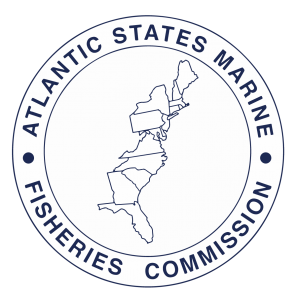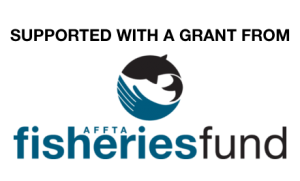ASMFC Draft Amendment 7 Has Been Approved
ASMFC 2022 Spring Meeting
Atlantic Striped Bass Management Board- Meeting & Final Action Summary
By Taylor Vavra (Vice President)
On May 4, 2022 the Atlantic Striped Bass Management Board approved Draft Amendment 7 to the interstate management plan. After more than 2 years of deliberation, hard work and public comment we now have a plan in place that will hopefully solidify the rebuilding of the stock. Did everything go as we had hoped? No, but this was still a big win for Striped Bass conservation.
During the PID portion of this process, Stripers Forever made the suggestion that we were in need of a equitable harvest moratorium (both recreational and commercial) to restore the stock. Unfortunately the ASMFC turned that around and offered only an option for a recreational harvest moratorium, something we could not support. If a harvest moratorium is put in place it absolutely needs to be an equitable one. Since the end of the last moratorium and the prolific seasons that followed, the ASMFC has done nothing but diminish the stock, ultimately leading to overfishing at a time of historically low recruitment. Many have lost faith and trust in the ASMFC’s ability to manage the stock and thus lead to us supporting what would have been the simplest and most full proof way of rebuilding it.
We were also in strong support of seasonal spawning closures as a method of protecting the SSB during the important pre spawn and spawning timeframe. Given the previously mentioned years of historically low recruitment, this would have potentially helped turn that around. There were a few reasons (outlined below) which contributed to that option failing.
Outside of those two items there are a multitude of options to be both excited about and proud of accomplishing. The overwhelming public outcry for accountability, quicker action and more conservation minded management could not be ignored by the board. To say that you played an important part in this outcome would be a major understatement. And for that, we could not be thankful enough.
Major accomplishments included; keeping the current 10 year rebuilding timeframe, keeping triggers and thresholds in place and in some instances improving them, requirements for the board to act quicker in the face of low recruitment and low SSB (spawning stock biomass) and likely most importantly, dramatically reworking CE (conservation equivalency) to limit its usage and close a loophole which previously allowed states to take advantage of it. The win on CE is enough to celebrate but as you will read below, there was so much more.
With Amendment 7 now in place the next major hurdle will be the results of the upcoming stock assessment, likely available sometime around October of 2022. Many believe we are in for some bad news on this front but only time and the data will tell. Based on those findings there is a good chance that either a moratorium or seasonal closures are back on the table as either no harvest or no target. We are fisherman too, we don’t look forward to not being able to get out on the water and chase Striped Bass. But at the same time, we need to do what is best for the fishery and if that means missing out on some fishing to let mother nature do her thing and rebuild the stock, then so be it.
Stripers Forever has been and always will be about doing what is the absolute best for the fishery, not our own self interests. We maintain a long term vision and hope of an abundant and healthy stock. The fish deserve it, as do our younger generations who have not had the chance to experience an abundant and healthy fishery.
Thank you for your continued support and for being a part of the process!
(At the bottom of this blog post you will find links to the audio and slides (YouTube video), presentations (PDF), ASMFC meeting summary and the ASMFC new release.)
FINAL ACTION SUMMARY
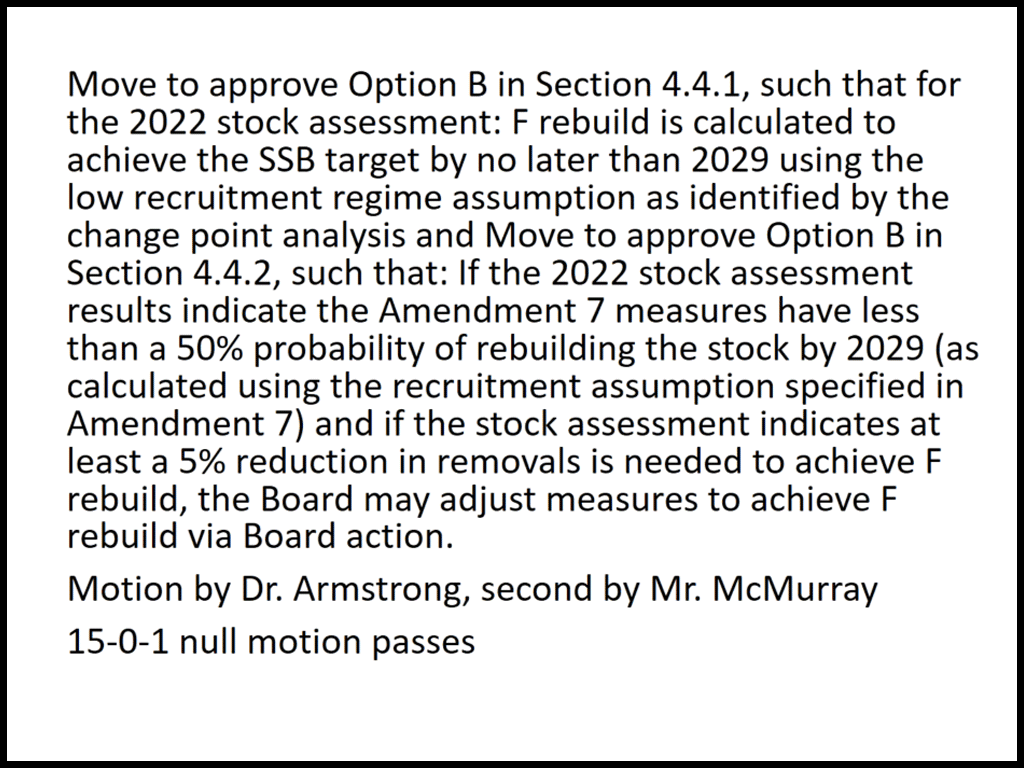
The meeting started off with a fairly quick discussion and vote on the rebuilding plan, section 4.4 of Draft Amendment 7. For section 4.4.1 the board approved option B, to rebuild the SSB to target level by no later than 2029. For section 4.4.2, again the board voted to approve option B, to allow for quick board action in the event that the next stock assessment indicates that we cannot rebuild the stock within the timeframe. We supported both of these options so let’s consider this a win. This is based off the “low recruitment regime assumption”, averaging the lower years of the juvenile abundance index (JAI) or young of year (YOY) instead of including some of the higher years. This is a more conservative and realistic approach to the rebuild.
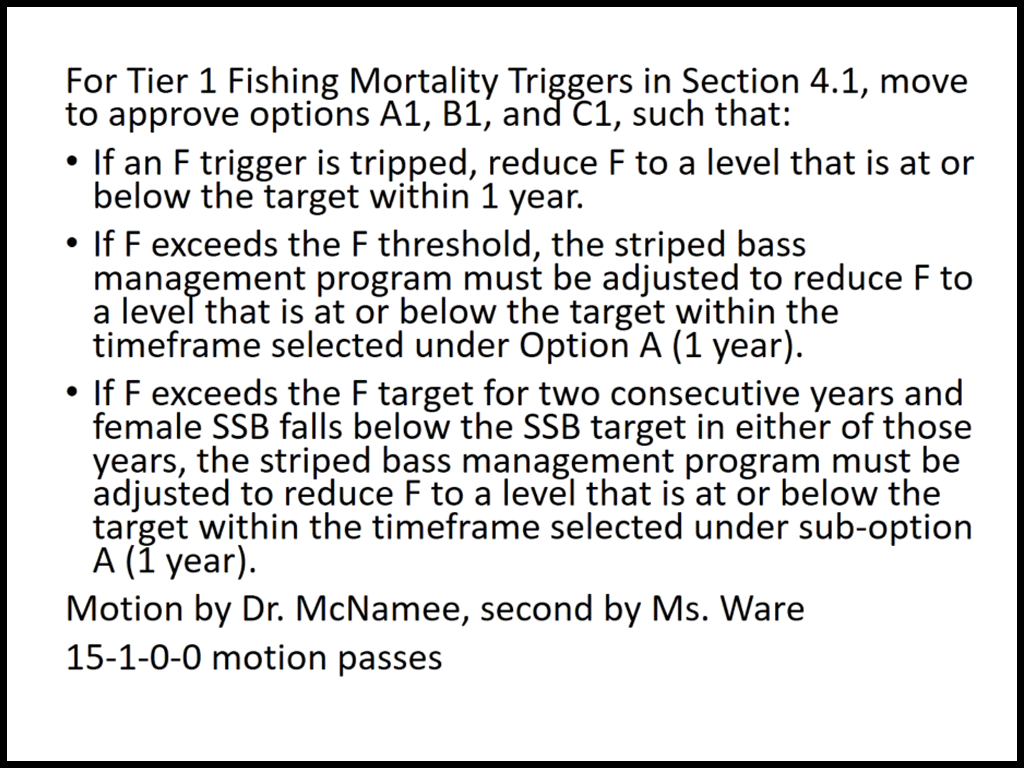
After a lunch break the board dived into the meat and potatoes of Draft Amendment 7 and started off with section 4.1 Tier 1 Fishing Mortality (F) Management Triggers. Another win here, we supported options A1, B1 and C1. While status quo options were selected, the board did not elect to approve any of the other sub options which would have weakened and allowed for longer timelines to reduce fishing mortality (F). Long story short, these were the best options on the table.
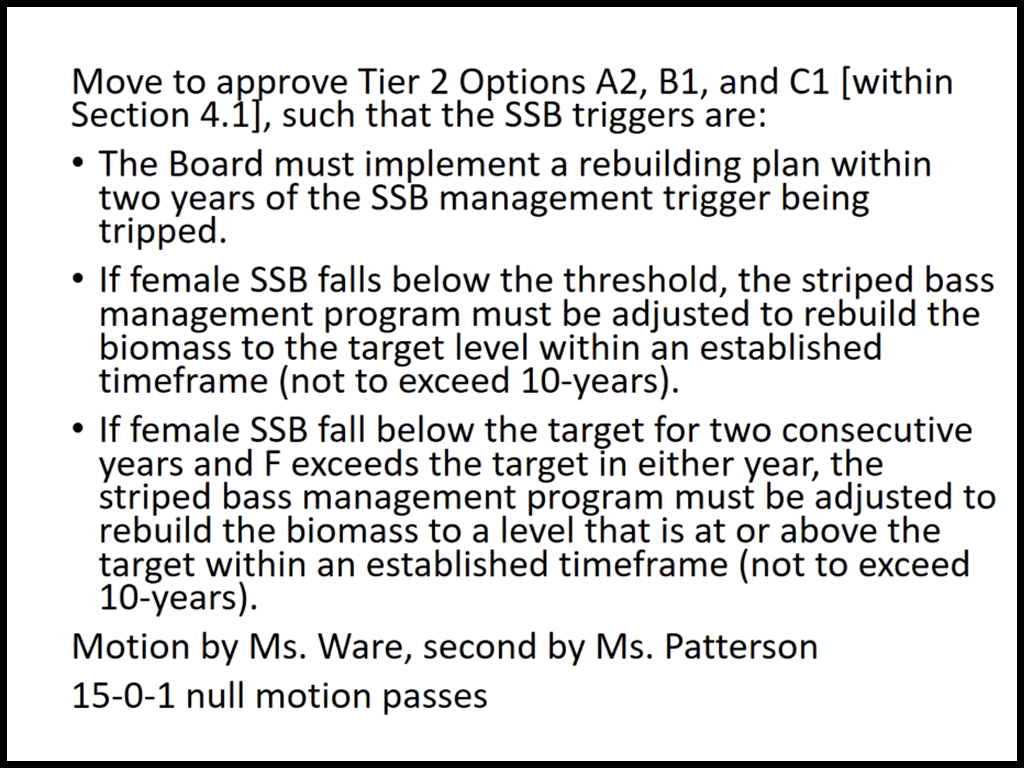
Moving on, the board then discussed Tier 2 options and with another quick vote approved sub options A2, B1 and C1. Another win across the board, we supported all three options approved. Sub option A1 did not put in place a deadline to implement a rebuilding plan. The board now must implement a rebuilding plan within two years of the SSB (spawning stock biomass) management trigger being tripped. Sub option B1 keeps in place a trigger if SSB falls below the threshold and C1 offers the shortest time frame to rebuilding if the female SSB falls below the target.
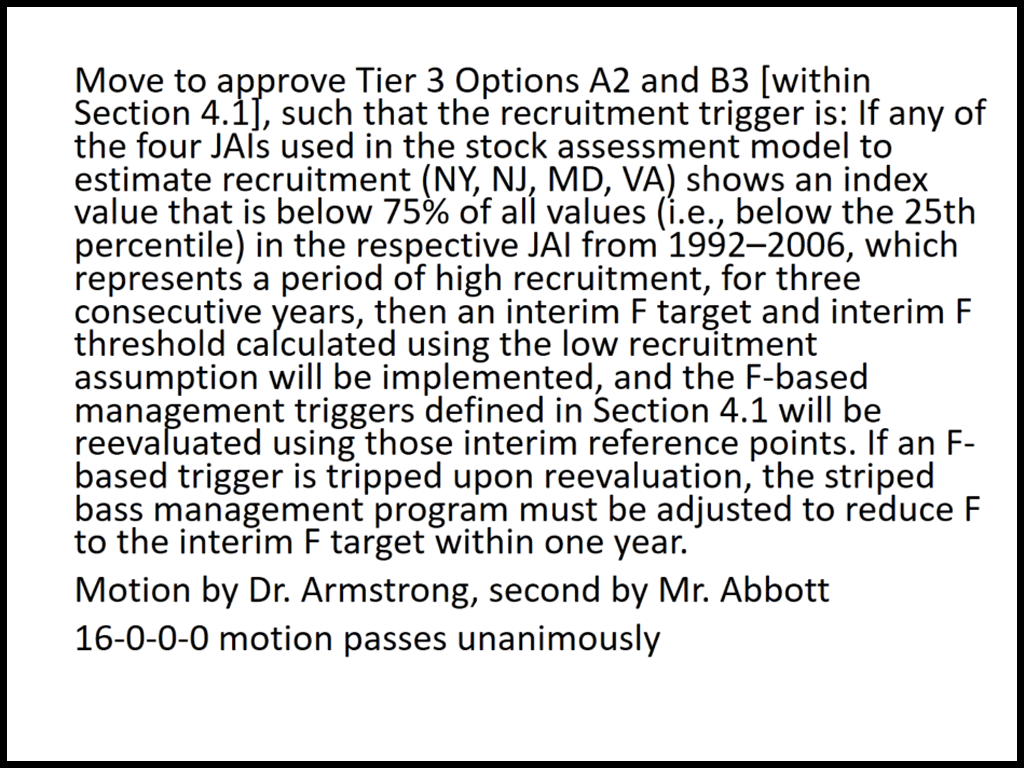
Next up were the Tier 3 options and Stripers Forever supported sub options A3 and B2. While the options we supported were not approved these options do improve on where we were at prior. A2 works off a ‘moderate sensitivity trigger’ as opposed to A3 which would be considered a ‘high sensitivity trigger’. B3 puts in place an interim F target and interim F threshold calculated using the low recruitment assumption and allows for reevaluation using those reference points. The management program then must be adjusted to reduce F to that interim target within the timeline defined in Section 4.1 (1 year).
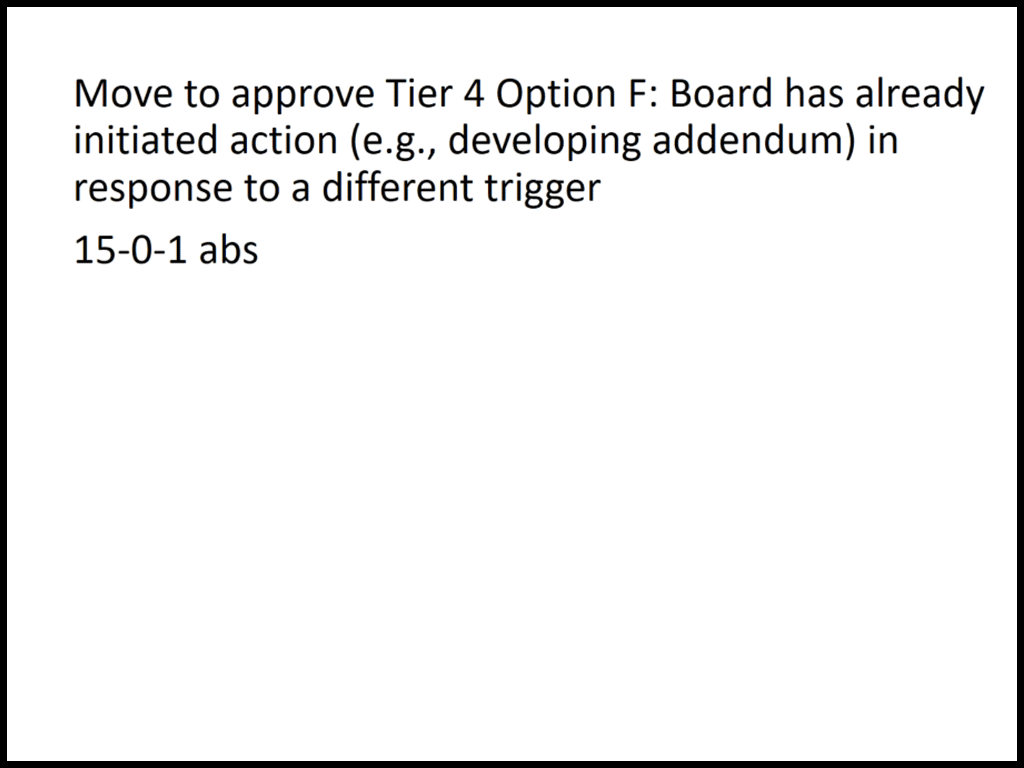
Lastly for section 4.1 the board discussed and voted on the Tier 4 Deferred Management Action sub options. The board approved sub option F, this was an unfortunate turn of events, the public has lost faith and trust in the board and wanted any deferred management options to be removed. This essentially creates a loophole where the board can defer action if action is already being taken in response to a different trigger. We will have to see how this plays out as things move forward. For now we have to chalk this one up to a lose, nothing horrific but this could open the door to problems in the future. We will have to cross that bridge when we get there and again speak up and hold the board accountable for their actions.
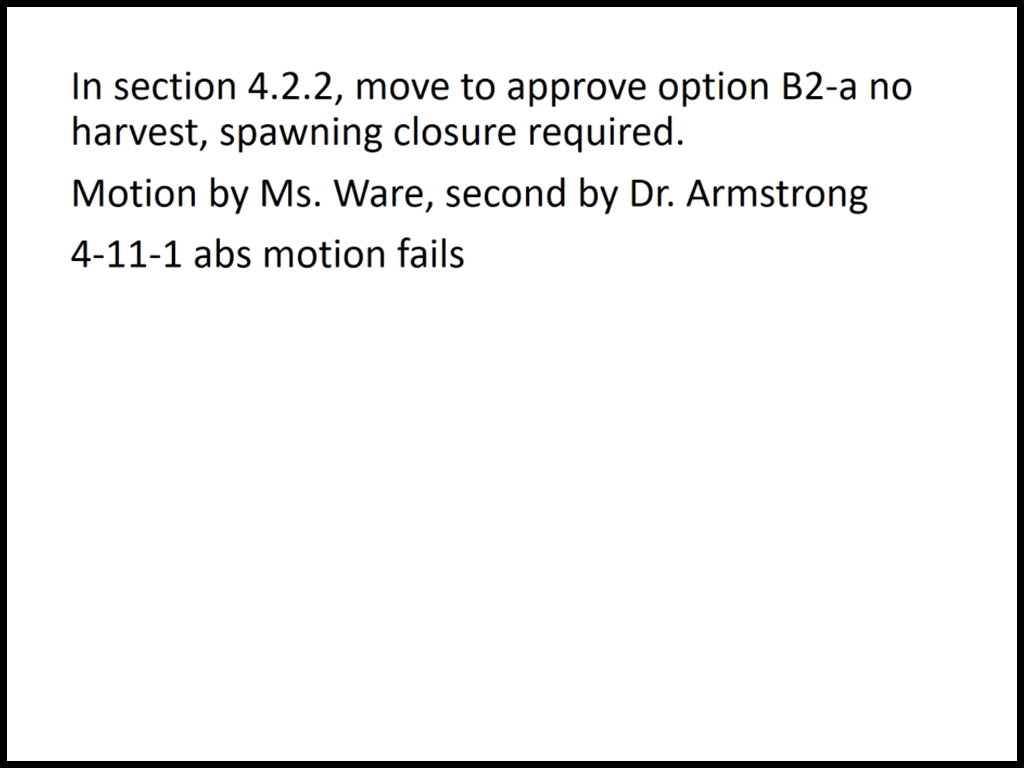
We supported sub option B2-B of section 4.2.2 because it would have provided the best protection for the SSB while they spawn. The motion on the table was for option B2-A, a required no harvest spawning closure. While not our first choice we would have been thrilled to see any type of spawning closure. Unfortunately the motion failed in a 4-11-1 vote. This was a lost opportunity to protect pre spawn and spawning fish which we believe is vital to the recovery of the SSB and stock as a whole. Many other species benefit from shortened seasons or spawning closures and Striped Bass should as well. Especially considering the stock is currently overfished with overfishing occurring, the least we can do is allow for a short window of uninterrupted spawning. There were several factors which contributed to this vote, enforcement and compliance at the top of the list. The claimed inability to enforce these closures is an excuse not to enact them, not a reason. Putting the no target closure aside, a no harvest closure is easily enforceable, especially in a place like the upper Hudson River where there are fewer species being targeted during that timeframe and a much smaller geographic area to cover. The board needs to put the fish first and let the states develop and fund the enforcement needed to make these options a reality. Compliance was another driving factor as there was a (largely unsubstantiated) claim that the current 80% compliance estimate is likely inaccurate and therefore would make this option pointless. This is largely an unfounded claim, with substantial penalties put in place on the enforcement side we believe the 80% compliance estimate is easily reachable if not surpassed. This is where gear and boat seizures could have played an important role in dissuading anglers from breaking these laws. We may be having this conversation again based on the outcome of the next stock assessment next fall.
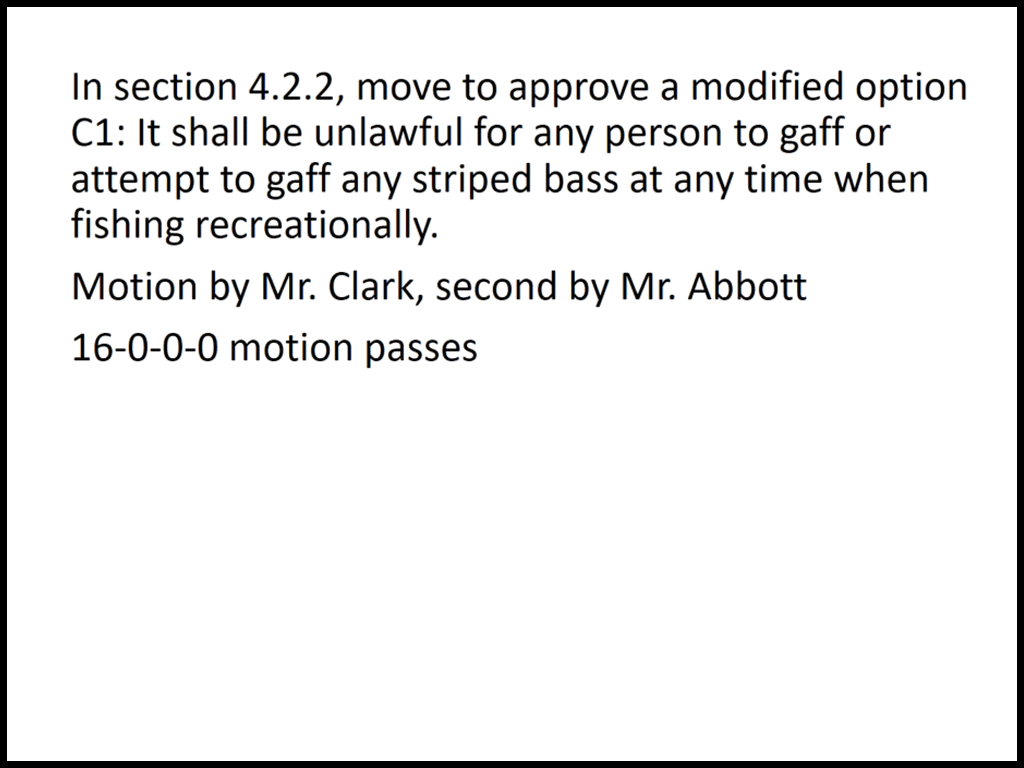
With a unanimous vote the board approved a modified version of sub option C1 of section 4.2.2 which would make it unlawful to use a gaff when fishing for Striped Bass. This is a no brainer, gaffing fish with the current state of the stock just makes no sense. Very happy to see this option approved.
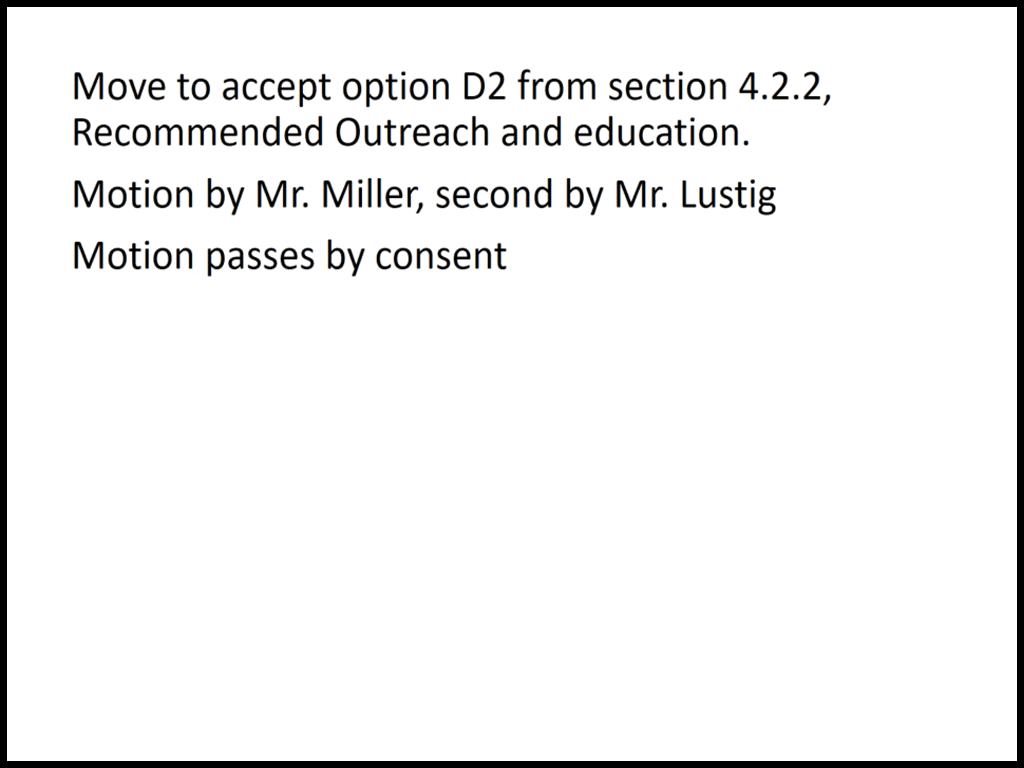
Stripers Forever supported sub option D1 would have required states to perform outreach and education. We believe both of these items are essential to reducing recreational discard mortality, potentially accounting for 50%, it is believed to be one of the biggest contributors to overall mortality. We did not want to give states the option to do so. It seems that states are aware of its importance and hopefully take the action needed. Either way we will certainly make a major effort to improve our contribution in these outreach and education efforts.
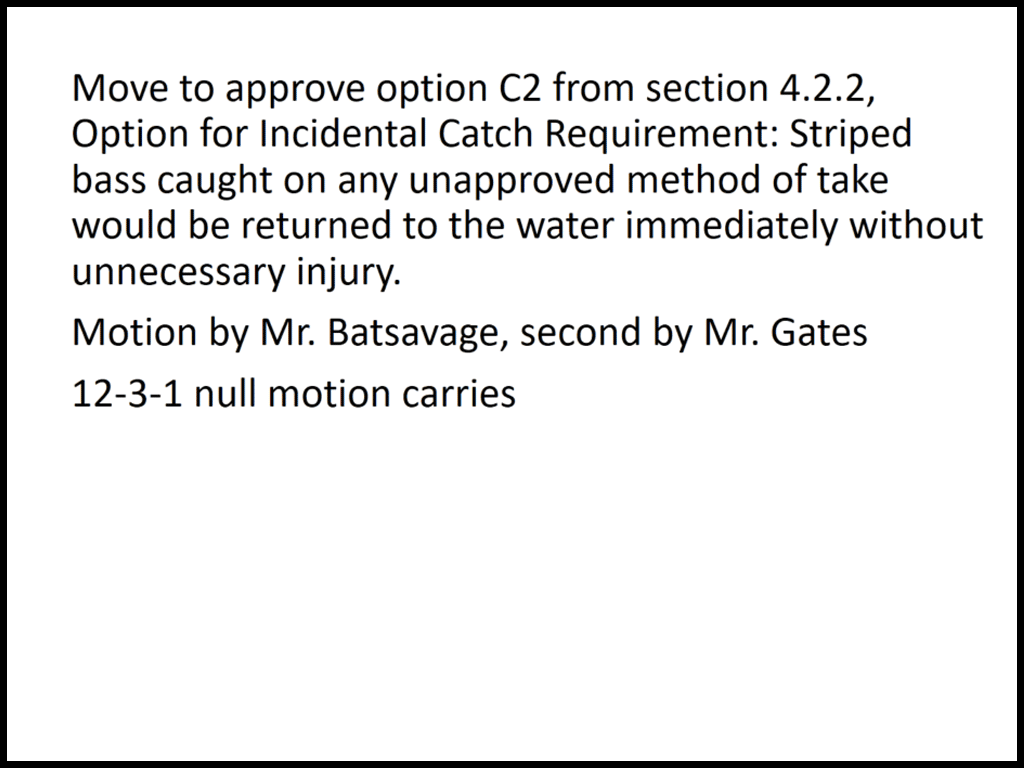
This was another easy choice and we are happy to see sub option C2 of section 4.2.2 approved. If fishing for other species on unapproved gear (think bait fishing with a j-hook for sea bass or blackfish) a by-catch Striped Bass must be returned to the water immediately without unnecessary injury.
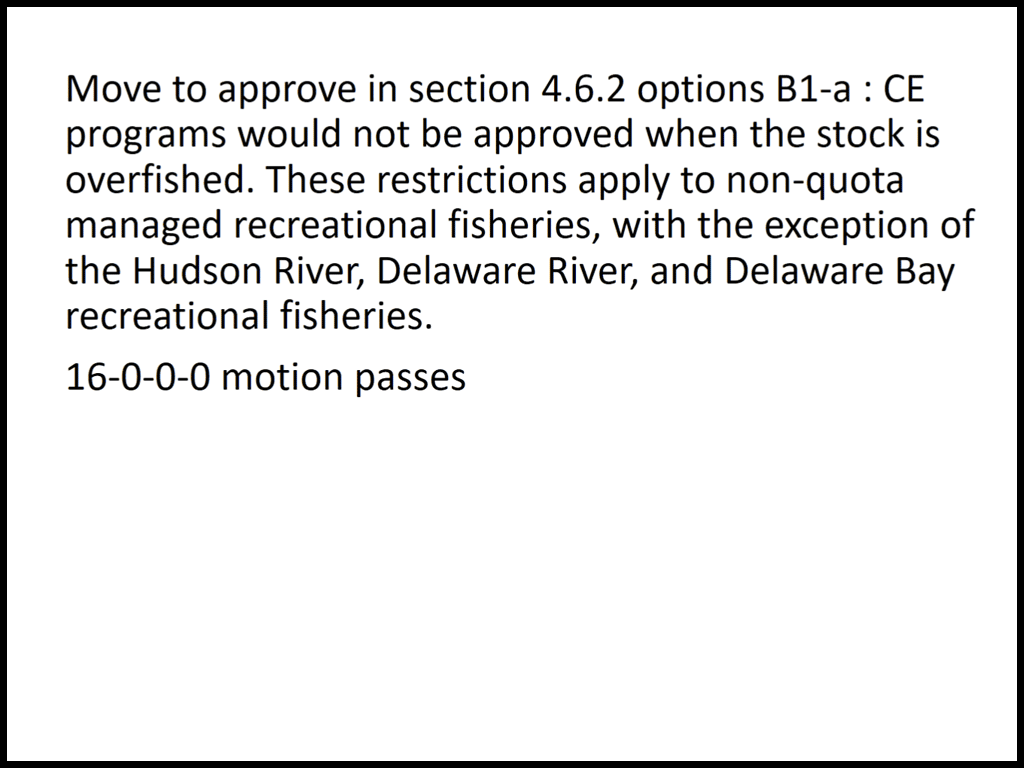
Finally the board began to address section 4.6 Alternative State Management Regimes. This was a very important section and we were very happy with the results. First up, the board approved sub option B1-A. CE (conservation equivalency) programs would not be approved when the stock is overfished. This was a major win and will prevent states like Maryland and New Jersey from taking advantage of CE to avoid reductions to rebuild the stock. CE has no place in a fishery which is currently overfished with overfishing occurring.
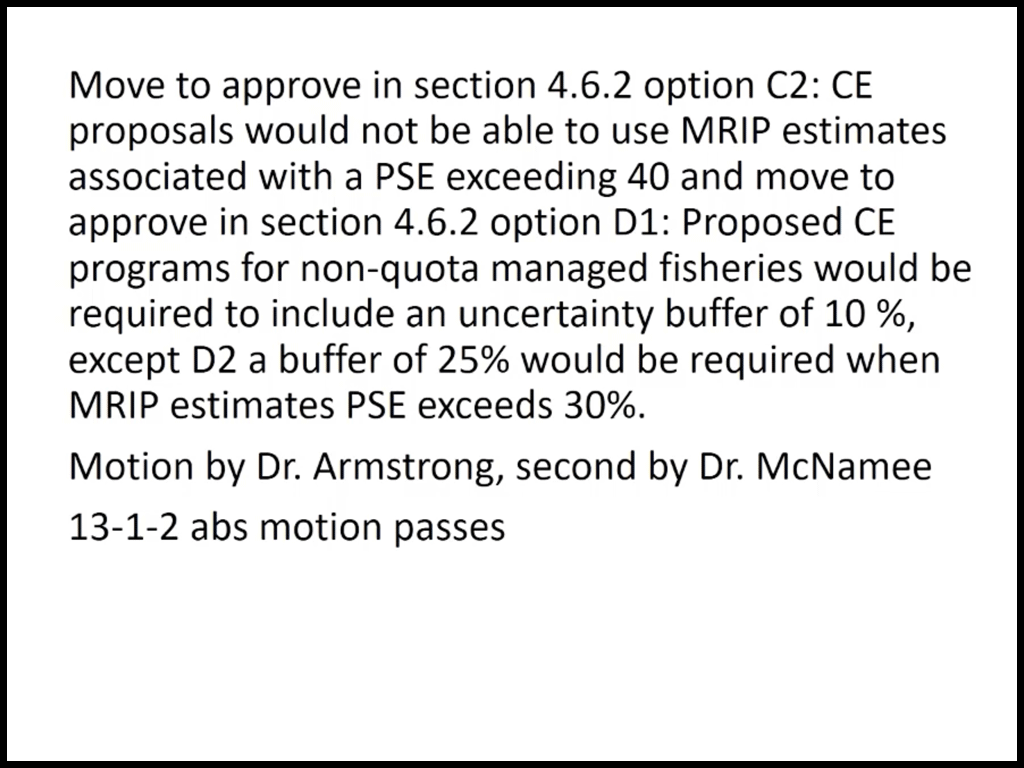
Options C & D of section 4.6.2 were up next. We supported sub options C3 and D3 which operated on the tightest estimates, least amount of risk and largest buffer. We would have liked to have seen more conservative options selected but this is still an improvement and further limits and dissuades CE usage.
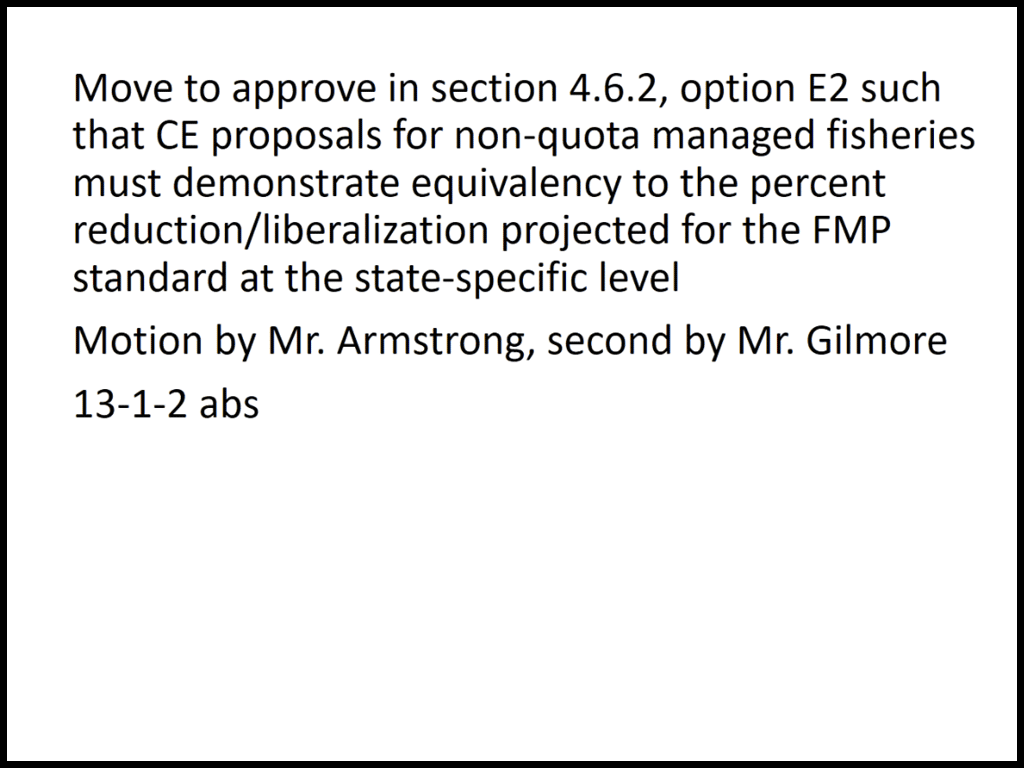
Another big win here in the battle to limit CE damage. Stripers Forever supported the approved sub option E2. Coast-wide reductions, like the most recent 18%, affect each state differently, some states represent a larger share than others. Up until now CE has essentially created a loophole where states could implement CE to avoid taking their full share of the reduction. Point and case, New Jersey during the last 18% coast-wide reduction. This is a bit complicated but, the condensed explanation is that option E2 requires states who choose to implement CE to take on their full share of the reduction under the coast-wide measures.
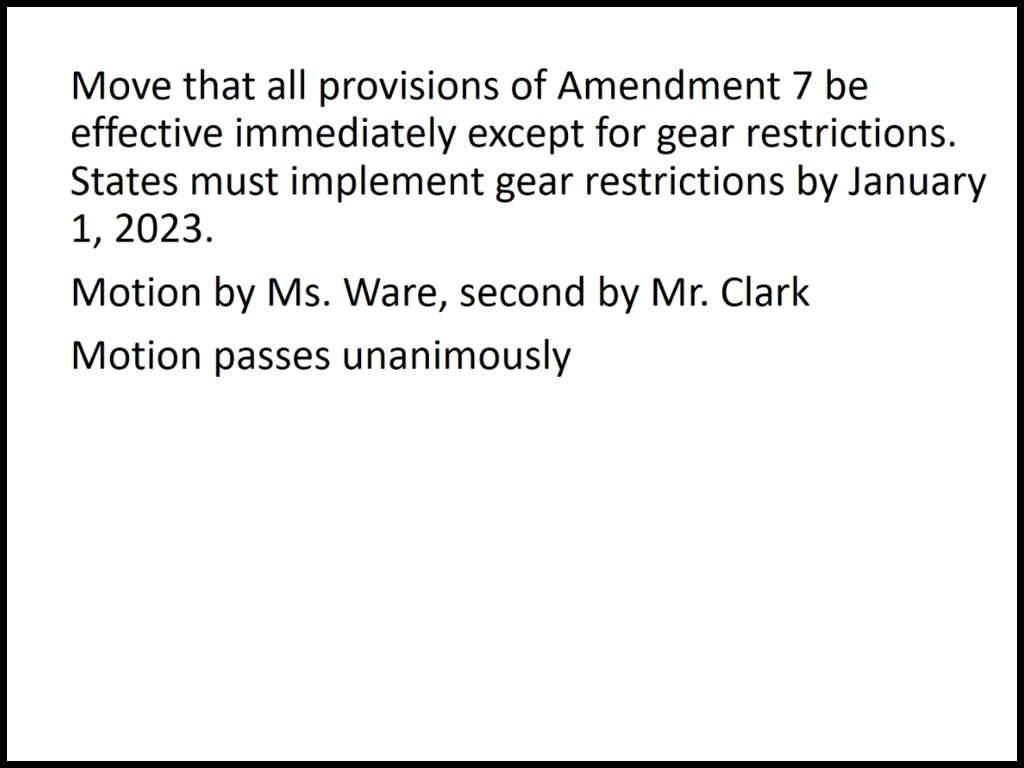
The beginning of the end. Motion passes unanimously and all provisions of Amendment 7 as approved above are now effective immediately.
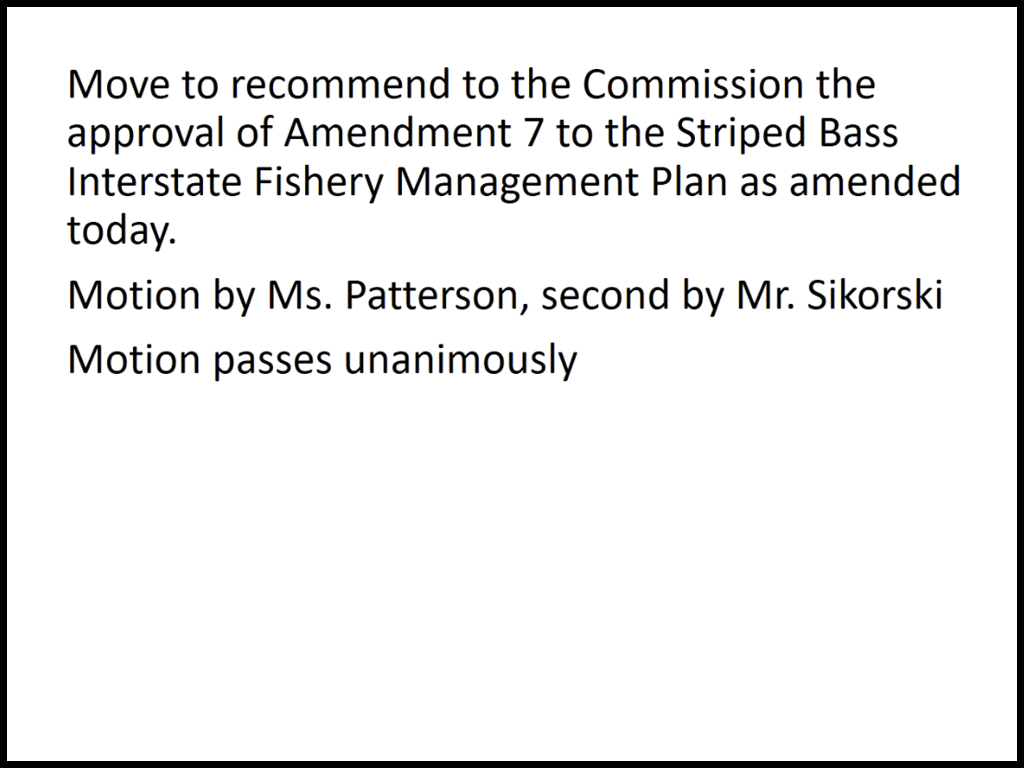
Amendment 7 to the the Striped Bass Interstate Fishery Management Plan (as amended today) was unanimously approved by the board. This is a huge moment for Striped Bass and a huge step forward in what we hope will be the rebuilding of the stock. While everything did not go our way, this is still a big win for Striped Bass.
LINKS:
- Atlantic Striped Bass Management Board 2022 Spring Meeting- Audio & Slides (YouTube Video)
- Atlantic Striped Bass Management Board 2022 Spring Meeting- Presentations (PDF)
- Atlantic Striped Bass Management Board 2022 Spring Meeting- Summary
- Atlantic Striped Bass Management Board Amendment 7 Approved- News Release
